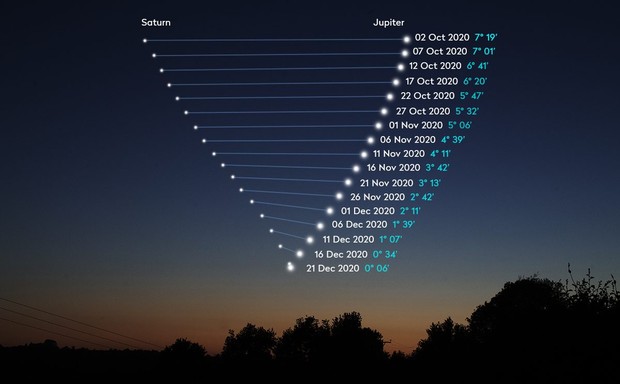In astronomical terms, the star of Bethlehem is the triple conjunction of Jupiter and Saturn in Pisces. The quantity ‘triple’ refers to the number of times the conjunction (of only two planets) occurs within a single season. ‘Pisces’ is the Latin name for the zodiacal sign of Fish. The first important step towards this discovery was made by Johannes Kepler. Contemporary theologians largely disregarded his 1605 book De Stella Nova in Pede Serpentarii. These theologians had little idea of astronomy, though, and that is not the optimal basis for judging an astronomical work. In this blog I will show that the 2020 great conjunction was not the star of Bethlehem: it has a recurrence of 20 years only, while the star of Bethlehem recurs once every 854 years at least.
A conjunction of Jupiter and Saturn is called a “great conjunction”, for involving the two slowest walkers visible to the naked eye. Jupiter and Saturn walk slowest because they are the most distant from the sun (again, among those planets visible to the naked eye). In absolute size, they are the two largest planets of our solar system. The largest planets in angular size, as seen from the earth, are the moon and Venus. Venus is closer to the sun than the earth, whence Venus is never visible during a full night: it is visible only short after sundown or short before sunrise. Mars has an angular diameter (as seen from the earth) of 0.6″, an order of magnitude smaller than that of the 7 times more distant Saturn (17″), let alone that of Jupiter (37″), which circles at about half Saturn’s distance from the sun. For your reference: 60 arcseconds make one arcminute (60″ = 1′), and 60 arcminutes make one degree (60′ = 1°). The angular diameter of the moon and of the sun are both around 30′, which is half a degree. Hence it takes 180 sun or moon diameters to cover the full right angle from horizon to zenith, which is much more than people usually imagine.
Chronicles of the Worcester Priory of 1377 report a special kind of great conjunction (see Hughes, p. 127), already known since at least 1285. This special kind of great conjunction consists of three subsequent great conjunctions within one season. That is to say, Jupiter and Saturn, approach and diverge three times within a few months. For this reason, it is called a triple conjunction: not because of the number of planets involved (Jupiter and Saturn), but because of the number of times they approach within one season.
A final crucial aspect of the triple great conjunction in Bethlehem, at least for the magi, was its position in the stellar constellation Pisces (fish). Jupiter was the new King, which surpassed and leaves behind Saturn, the old King. Why did the magi come to Jerusalem? Because for them, the constellation Pisces was attributed to the Jews. Hence, the star of Bethlehem did not point anywhere, but its position in the sky referred to the Jewish people. A triple great conjunction in Pisces: that is the astronomical event we are talking about. In the appendix we show that its lowest recurrence period is 854 years.
The trick the Wikipedia site uses to hide all this information from the reader, is to center all attention on the closeness of approach. That is, scientifically speaking, a perfectly valid object of study; yet, it tells us nothing about how astronomers of antiquity observed these phenomena: and without their keen interest in it, today nobody would care at all. The closest approach only became measurable with high altitude, firmly grounded, high quality telescopes of the 18th century. What the magi went out seeing, was not at all related to the closest approach of Jupiter and Saturn: they knew perfectly well that from Jerusalem they would observe nothing different as from their own palaces. In today’s scientific terminology, they were not so much interested in the latitudinal separation of the two planets (the difference in their distance from the horizon), as in the longitudinal one (the difference in their position along the horizon). Whereas in ordinary conjunctions the longitudinal paths of Jupiter and Saturn cross only once, in a triple conjunction they cross three times within one season: as if they had a one-season dance with each other, before departing again. To the astronomers of old, such a close dance was an even more curious phenomenon than it is today.
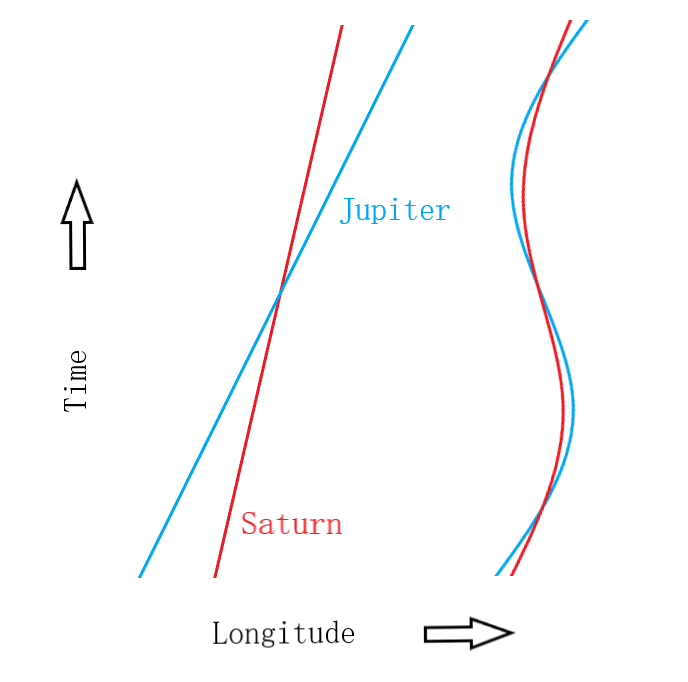
Longitudinal motion of Jupiter and Saturn in a single (left) and triple conjugation (right)
the total time elapsed across the diagram is about half a year
the apparent backward motion of the planets in a triple conjunction is due to the movement of the earth (see diagrams below)
single conjunctions occur about once every 20 years, triple conjunctions once every 40, 119, or 257 years
The following series of simplified schematics might help understanding the basics of the triple conjunction. The fundamental ingredients were probably known to the astronomers of old: the distances in the heliocentric system (proposed three centuries before), and the angular revolution velocities of the planets involved. The latter scale as 60:5:2 for Earth, Jupiter, and Saturn, respectively, and their distances from the Sun as 1:5:10.
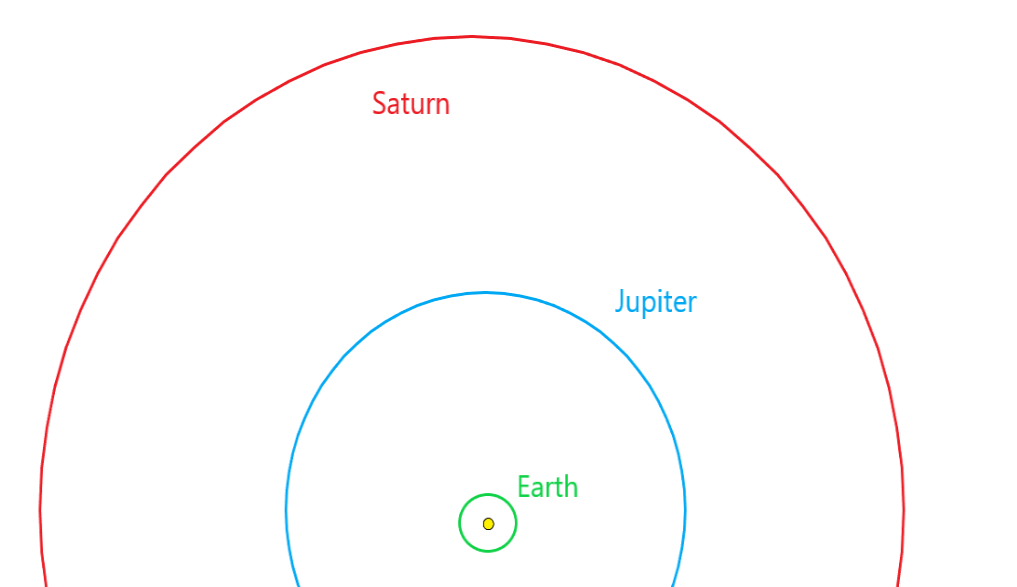
Planetary Orbits Around the Sun
The diameter of the sun is roughly 1% of the distance from the sun to the earth, whence hardly visible on this scale; the planets would be invisibly small dots
Please try to follow me in this unconventional pedagogical approach: instead of starting with the most simple case (the single conjunction), we first study the most difficult one (the triple conjunction). The series of diagrams below illustrates the physical origin of a triple conjunction.
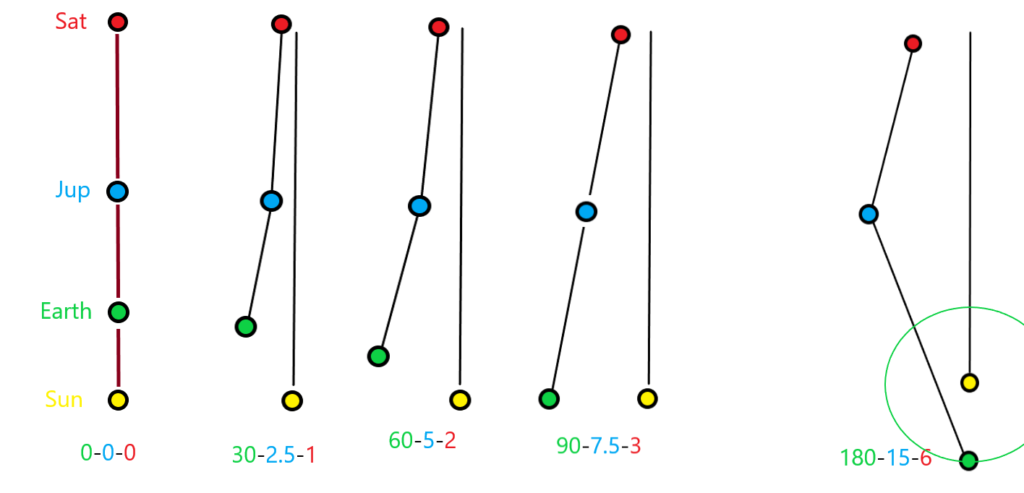
The view is from the ecliptic north pole: that is, we look upon Earth’s north pole. In this view, the planets move counterclockwise, or in mathematical terms, with an ever increasing angle. The three conjunctions occur at Earth’s orbital angles -90 degrees (not shown), 0 degrees (first diagram), and +90 degrees (fourth diagram). In the fifth and last diagram, the Earth is at +180 degrees, and already far beyond the triple conjunction. The second and third diagrams illustrate how, immediately after the second conjunction, Earth, Jupiter, and Saturn form an angle of the “larger than” sign (>). Half a year after the second conjunction (last diagram) the planets form an angle of the “smaller than” sign (<). Consequently, somewhere in between the third and fifth diagrams, there must be a transition (from “>” to “<“) where the planets are again aligned: That transition marks the third conjunction in the triple series (fourth diagram). Here it is conveniently depicted as occurring 4 months after the second conjunction (corresponding to a rotation of the earth about the sun of 90 degrees), but in practice it takes less than 4 months. The reason is that the earth’s orbit is a little too large, for reasons of easier appreciation of the angles. The first conjunction results upon mirroring the whole picture around the 0-0-0 axis of the first diagram, whence it occurs 4 months before the second conjunction. The numbers in green, blue, and red, indicate the degrees between the depicted angle and zero angle (right above the sun) for Earth, Jupiter, and Saturn, respectively. They are all negative in the mirrored diagrams. Whenever the Sun-Earth axis surpasses a Sun-planet axis, the planet in question seems to be moving backward in the Zodiac. When the Sun-planet axis is perpendicular to the Sun-Earth axis, the planet moves froward through the Zodiac at its average speed (the speed seen from the sun), and when the Earth and the planet are aligned, though at opposite sides of the sun, the planet seems to move forward more than twice as fast.
Now we can understand how a single conjunction comes about. We start out with the alignment of Sun, Jupiter and Saturn, though with Earth lagging by 15 degrees (two weeks). By following the course of the planets, one can see but a single transition from “<” to “>”. This is the essential difference with the previous graph, showing (when appropriately mirrored) three transitions within half a year.
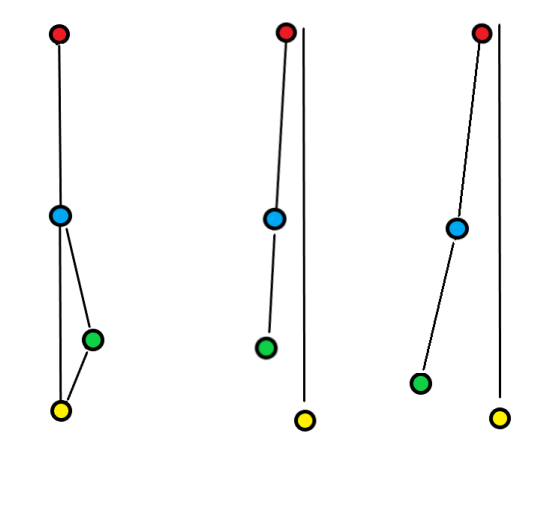
When Earth lags the solar conjunction by two weeks (first diagram: Earth at -15 degrees)
the single conjunction occurs around a month later (second diagram: Earth at +15 degrees)
Another month later, the Saturn-Jupiter-Earth-angle has switched from < to > (third diagram: Earth at +50 degrees)
The magi probably lived in Babylon or further eastward. When they saw the first conjunction in from their own palaces in April 7 BC, they knew that this conjunction was to be an extraordinary one, of the triple kind, recurring every 139 years. As the conjunction occured in the zodiacal sign of Pisces, they undertook the travel to Jerusalem. The second conjunction occurred toward the end of September. Depending on their land of origin, they were still on their way to Jerusalem, or they might have arrived already. The third conjunction occurred early December 7 BC, and the subsequent separation of the two planets would be visible from January 6 BC onward.
Somewhere during the travel, the conjunction was hidden from their view, possibly due to the landscape. If they traveled along the Jordan river (providing a permanent source of water) they would have ascended to Jerusalem (elevation 750 meter, or 2470 feet) from Jericho (-260 meter, or -850 feet). This implies a final stretch through a canyon with sharp slopes both at the east and at the west (see image below), which would significantly constrain the visible part of the sky, thus hiding the conjunction.
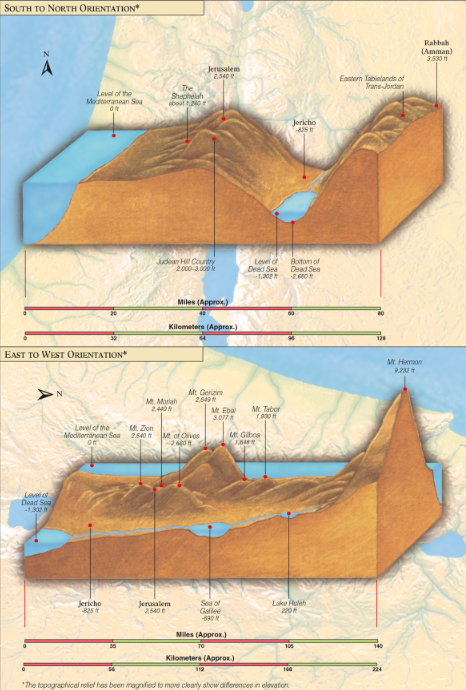
Altitude map in the form of intersections perpendicular to the north-south (above) and east-west (below) directions
What does this all mean for the exceptional nature of the Star of Bethlehem? First of all, it was exceptional only to scientists of the time. Ordinary people had not noticed anything strange, and certainly not a very bright star. That brightness is mere imagination of an apocryphal source (the proto-evangelium of James). As far as its recurrence is concerned, 1549 years is exceptional enough (the average time between one triple great conjunction in Pisces and the next). It is so exceptional, that many friends of mine wonder why I am not interested in the 2020 great conjunction. The reason is that it is a single conjunction, of the kind that occurs once every 20 years. See you in 2040! The last triple conjunction occurred in 1981, and it was not in the sign of Pisces. Neither will be the next one, in AD 2238. That will be for the grandchildren of our grandchildren of our grandchildren to see.
Matthew mentions a “star”, because the term “planet” would have been unknown to the large majority of his readership. If Matthew had known the astronomical details of a triple great conjunction, mentioning them would have been useless without reference to a handbook of astronomy: Equally unavailable to the large majority of his readership.
The exceptional nature was not in the approach (roughly one astronomical degree, which is about twice the angle spanned by the moon diameter), but in the threefold oscillatory motion of Jupiter and Saturn at their meeting point in the zodiacal sign of Pisces. For specialists of astronomy at that time, a triple great conjunction was known as an extremely rare event. The Magi were extremely happy to see the great conjunction again in Jerusalem, because it confirmed their scientific expectations: they knew that the conjunction had not disappeared, but that it was temporarily hidden from their sight whenever they trod steep mountain slopes. What they did not expect at all, though, was that the King of the Jews was not born in the Royal Palaces of Jerusalem, but in some obscure shepherds’ village (where David had grown up): Bethlehem of Ephrata, which, in the context of the new King’s birth, was known only to specialists of the Holy Scripture.
Appendix: Mathematics of the Star of Bethlehem
A solar conjunction is the alignment of two planets and the sun. These are spaced by a fixed period of time, and easy to calculate, when one applies a triple approximation: (i) the planetary orbits are perfect circles, (ii) the position of the sun is static, and (iii) all planets move in a single plane: the earth’s ecliptic plane.
The mathematics needed to figure out find out the period between two subsequent solar conjunctions is elementary. Like the relation between position (x), velocity (v), and time (t), you learnt at high school (x = v*t), one may express the number of turns a planet moves around the sun as n = f*t, where f stands for the frequency (number of turns per year). A turn is completed when the planet “p” reaches np = 1, or any other integer number. This should occur after every planetary orbit time Tp. This yields the condition 1 = fp * Tp, also known as the frequency relation fp = 1/Tp.
As Jupiter is closer to the sun than Saturn, TJ < TS whence fJ > fS. Define time zero as the moment in which Jupiter and Saturn are aligned with the sun. Define the next time at which they are aligned as TJS. Between time zero and TJS, Jupiter has revolved exactly one cycle more than Saturn: nS = nJ +1, which can be rewritten as fS * TJS = fJ * TJS +1. Dividing both sides of the equation by TJS, and replacing the frequencies by inverse periods, one obtains 1/TS= 1/TJ + 1/TJS, which is usually written as 1/TJS = 1/TJ – 1/TS.
With TJ = 11.8620 yr, and TS = 29.4571 yr, it follows that TJS = 19.8589 yr. That is the answer to the first question: TJS is the time span between one solar conjunction, and the next. An earth-perceived conjunction (alignment of Earth and two planets) always has its associated solar conjunction (alignment of Sun and two planets), as we showed in the second series of diagrams. Since the period between solar conjunctions is fixed, and that between earth-perceived conjunctions varies, it is simpler to calculate the solar conjunctions, and from there, derive the associated earth-perceived conjunction.
Like moon eclipses, great conjunctions come in series, too. There are six of them, whence within a series, the recurrence time is 6TJ = 119.15 yr. We will now see where these numbers originate from. Every period TJS, Earth circles forward 360°*0.8589 with respect to angle zero. In that period of time, Saturn moves forward 360°*TJS/TS = 360°*0.6742, and Jupiter 360°*TJS/TS = 360°*1.6742: these angles differ by exactly 360°, by construction. Convention has it that 60 arcminutes make one degree (60’=1°), and 60 arcseconds make one arcminute (60″=1′). Hence, every period TJS, the Sun-Earth axis leads the Sun-Jupiter-Saturn axis by 360°*(0.8589–0.6742) = 360°*0.1847=66°30′. For N=6, the angular difference between the Sun-Earth and the Sun-Jupiter-Saturn axes reduces to 38°57′, and for N=21, to –34°40′. Hence, N=1*6+1*21=27 (corresponding to 536.19 years) has a lead of 4°14′, and N=1*1+2*21=43 (corresponding to 853.93 years) a lag of 2°11′. By alternating three periods of N=43 with two periods of N=27, one achieves a spectacularly low lead of 36″. It takes about 60 of them to walk through Pisces, whence N=3*43+2*27=183 is a higher bound to the recurrence time of the Star of Bethlehem. For a lower bound on the recurrence time of the Star of Bethlehem, one needs not only good alignment of Earth, Jupiter, and Saturn (by minimizing the leads/lags), but also that the Earth completed an integer number of cycles: else the conjunction would be triple, but it would not be located in Pisces. Every sign of the Zodiac spans about 30° (there being twelve of them). Since N=43 has a lag of only 25°, it is possible that two triple conjunctions occur in Pisces, spaced by 43TJ or 854 years. At a third triple conjunction, the earth will have moved 50°, whence a longer period is required.
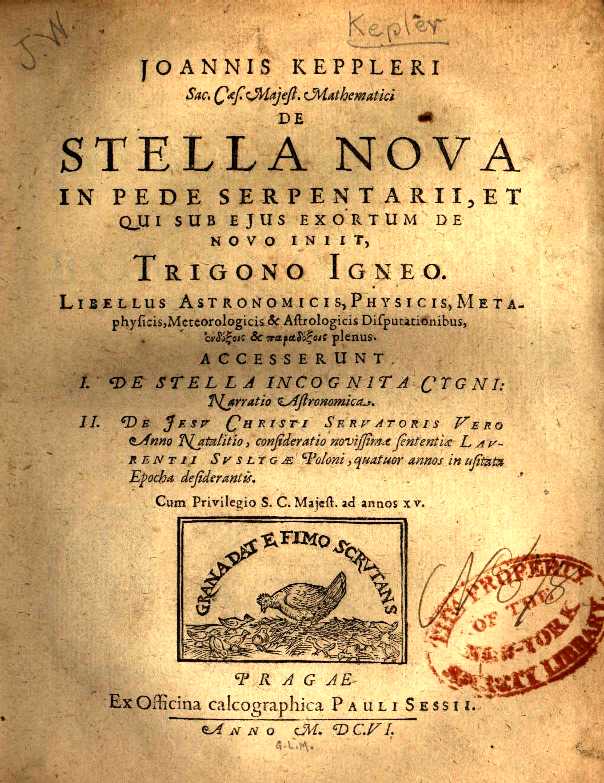
Front Page of Kepler’s “De Stella Nova” (about the new star)
